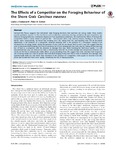The Effects of a Competitor on the Foraging Behaviour of the Shore Crab Carcinus maenas
Date
2014-04-01Author
Subject
Metadata
Show full item recordAbstract
Optimal Diet Theory suggests that individuals make foraging decisions that maximise net energy intake. Many studies provide qualitative support for this, but factors such as digestive constraints, learning, predation-risk and competition can influence foraging behaviour and lead to departures from quantitative predictions. We examined the effects of intraspecific competition within a classic model of optimal diet--the common shore crab, Carcinus maenas, feeding on the mussel, Mytilus edulis. Unexpectedly, we found that breaking time (Tb), eating time (Te), and handling time (Th) all decreased significantly in the presence of a conspecific. Reduced handling time in the presence of a competitor resulted in an increased rate of energy intake, raising the question of why crabs do not always feed in such a way. We suggest that the costs of decreased shell breaking time may be increased risk of claw damage and that crabs may be trading-off the potential loss of food to a competitor with the potential to damage their claw whilst breaking the shell more rapidly. It is well documented that prey-size selection by crabs is influenced by both the risk of claw damage and competition. However, our results are the first to demonstrate similar effects on prey handling times. We suggest that crabs maximise their long-term rate of energy intake at a scale far greater than individual foraging events and that in order to minimise claw damage, they typically break shells at a rate below their maximum. In the presence of a competitor, crabs appear to become more risk-prone and handle their food more rapidly, minimising the risk of kleptoparasitism.
Collections
Publisher
Place of Publication
Journal
Volume
Issue
Pagination
Number
Recommended, similar items
The following license files are associated with this item:


